电子科大数字信号处理课件
合集下载
电子科大数字信号处理课件
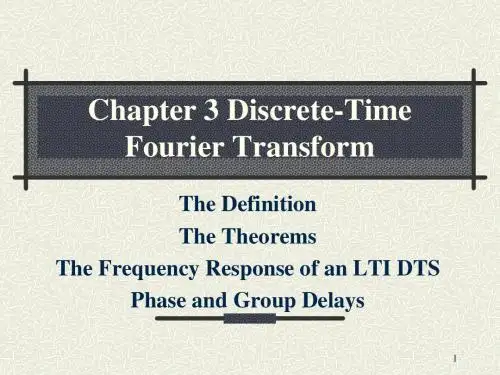
- () called the principal value.
19
20
The DTFTs of some sequences exhibit discontinuities of 2 in their phase responses. An alternate type of phase function that is a continuous function of is often used. It is derived from the original phase function by removing the discontinuities of 2.
X a ( j) X a ( j) e ja ( )
9
3.1.2 Energy Density Spectrum
The total energy x of a finite-energy continuous-time complex signal xa (t ) is given by: 2 x xa (t ) dt
Time-domain k a k [n k ] (a weighted linear combination of delayed unit sample sequences.)
Transform-domain a. frequency domain b. Z domain (a sequence in terms of complex exponential sequences of the form{ e jn } and { z n }.
Applying the CTFT to both sides, we have:
Ya ( j) H a ( j) X a ( j)
《数字信号处理教程》课件

数字信号处理教程
欢迎来到《数字信号处理教程》PPT课件!本教程将介绍数字信号处理的基本 概念、采样与量化、时域和频域的分析方法等内容,让您全面了解这一重要 领域。
信号处理的基本概念
了解什么是信号和信号处理,掌握信号的基本性质和特点,以及信号处理的 应用领域。
采样与量化
学习信号的。
时域和频域的分析方法
探索时域和频域的不同分析方法,如时域图像和频谱图的应用。
傅里叶级数和傅里叶变换
了解傅里叶级数和傅里叶变换的原理和应用,掌握频域分析的关键技术。
连续时间系统和离散时间系统
掌握连续时间系统和离散时间系统的基本概念和区别,以及它们在信号处理 中的作用。
差分方程和传输函数
学习差分方程和传输函数的概念和计算方法,掌握数字滤波器的设计和分析。
离散时间傅里叶变换
了解离散时间傅里叶变换的原理和应用,掌握时频分析和滤波器设计方法。
欢迎来到《数字信号处理教程》PPT课件!本教程将介绍数字信号处理的基本 概念、采样与量化、时域和频域的分析方法等内容,让您全面了解这一重要 领域。
信号处理的基本概念
了解什么是信号和信号处理,掌握信号的基本性质和特点,以及信号处理的 应用领域。
采样与量化
学习信号的。
时域和频域的分析方法
探索时域和频域的不同分析方法,如时域图像和频谱图的应用。
傅里叶级数和傅里叶变换
了解傅里叶级数和傅里叶变换的原理和应用,掌握频域分析的关键技术。
连续时间系统和离散时间系统
掌握连续时间系统和离散时间系统的基本概念和区别,以及它们在信号处理 中的作用。
差分方程和传输函数
学习差分方程和传输函数的概念和计算方法,掌握数字滤波器的设计和分析。
离散时间傅里叶变换
了解离散时间傅里叶变换的原理和应用,掌握时频分析和滤波器设计方法。
课件:数字信号处理,第五章,电子科技大学
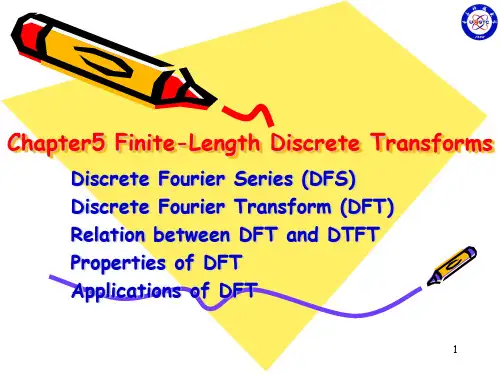
Example N-point DFT of x[n] cos nRN [n] 6 (N=12) is wanted.
Solution
X [k ] x[n]W
n 0
N 1
kn N
1 [e n 0 2
11
j
2 n 12
e
j
2 n 12
]e
j
2 kn 12
6, k 1, 11 { 0, orthers
Solution 2 Using (B), we get
1 j 12 n j 12 kn 1 j 12 n j 12 kn X [k ] [ e e e e ] 2 n 0 2
~ 11 2 2 2 2
1 11 j 12 ( k 1) n 1 11 j 12 ( k 11) n e e 2 n 0 2 n 0
• Making use of the identity
( k r ) n W N n 0 N 1
N , for k r N , l an integer 0, otherwise
we get
N / 2, G[k ] N / 2, 0, for k r for k N r otherwise
k
Example x[n] cos n 6 has DFS, the coefficients are wanted. Solution 1
1 x[n] e 2
~ 2 j n 12
~
1 e 2
2 j n 12
1 e 2
j
2 n 12
1 e 2
j
2 (11) n 12
电子科大《数字信号处理(DSP)》第8章 IIR系统的设计
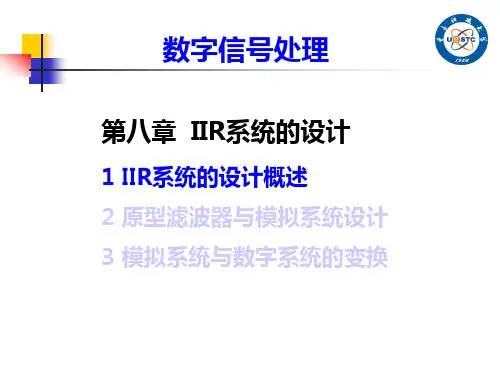
模拟变换法基本设计思想 设计目标幅频特性为: 设计目标幅频特性为:
H e jω
( )
−π <ω ≤π
将设计目标转换为模拟系统的幅频特性: 1 将设计目标转换为模拟系统的幅频特性:
H ( jω ) −∞ <ω <∞
设计满足要求的模拟系统: 2 设计满足要求的模拟系统: H (s ) 将模拟系统转换为数字系统: 3 将模拟系统转换为数字系统:
1型滤波器进行反转和 将Chebyshev 1型滤波器进行反转和 变量代换得到。 变量代换得到。
模拟原型滤波器: 模拟原型滤波器: Butterworth Butterworth原型滤波器: Butterworth原型滤波器:最平坦滤波器 原型滤波器
Mω =
2
( )
1 1+ ω
2N
H ( jω ) =
1 1 + ω 2N
模拟原型滤波器: 模拟原型滤波器: Butterworth 对于任意阶数N 对于任意阶数N,
( ) ( )
利用各种优化逼近设计方法, 利用各种优化逼近设计方法,可以得到 分式中的各优化系数。 分式中的各优化系数。
模拟滤波器基本设计步骤 根据幅频特性平方与系统函数的关系: 根据幅频特性平方与系统函数的关系:
H ( jω ) = H ( jω ) ⋅ H (− jω )= H (s ) ⋅ H (− s ) s = jω = G ( − s 2 )
−1
)
相关的MATLAB函数 相关的MATLAB函数 MATLAB
[N, wn] = buttors(wp, ws, Rp, Rs, 's')
给定滤波器的设计参数, 给定滤波器的设计参数,上述函数可以 求解出butterworth滤波器的最低阶数和求解出butterworth滤波器的最低阶数和butterworth滤波器的最低阶数和 3dB截止频率。 3dB截止频率。 截止频率
电子科大_信号与系统课件chap2
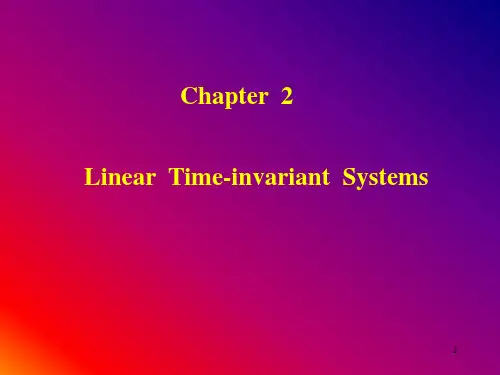
y
t
t
0
t d
1 t2 2
t 2T t 2T t 0
t
③ t T
ht
t 2T 0
T t 2T
1
yt
T
0
t d
Tt 1 T 2 2
t 2T
0
T
x
T17 t
Chapter 2
LTI Systems
Chapter 2 Linear Time-invariant Systems
1
Chapter 2
LTI Systems
Consider a linear time-invariant system
fi t yi t
i 1,2, , n
n
f t
ai fi t ti
yt
n
ai yi t ti
i 1
i 1
Example 1 an LTI system
f1 t
1
y1 t
L
1
0
2t
f2t f1t f1t 2
1
L
0 1 2t
y2t y1t y1t 2
1
0
2
4
t
0
2
1
-1
4t
2
Chapter 2
2 t 5t 2 xt
6 5t 24t 2 13t 3 22t 4 10t 5 6 2t 8t 2 4t 3
3t 16t 2 9t 3 22t 4 3t t 2 4t 3 2t 4
《数字信号处理原理》PPT课件
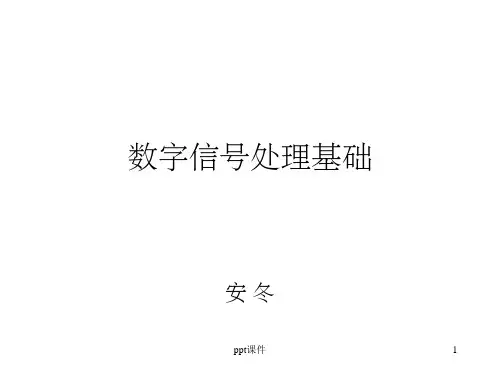
•Digital signal and image filtering
•Cochlear implants
•Seismic analysis
•Antilock brakes
•Text recognition
•Signal and image compression
•Speech recognition
•Encryption
•Satellite image analysis
•Motor control
•Digital mapping
•Remote medical monitoring
•Cellular telephones
•Smart appliances
•Digital cameras
•Home security
Upper Saddle River, New Jersey 07458
All rights reserved.
FIGURE 1-4 Four frames from high-speed video sequence. “ Vision Research, Inc., Wayne, NJ., USA.
Joyce Van de Vegte Fundamentals of Digital Signal Processing
ppt课件
11
Copyright ©2002 by Pearson Education, Inc.
Upper Saddle River, New Jersey 07458
All rights reserved.
Joyce Van de Vegte Fundamentals of Digital Signal Processing
电子科技大学数字信号处理复习提纲ppt课件
N 1
X (k) DFT[x(n)]N x(n)WNkn n0
k=0, 1, …, N-1
x(n)
IDFT[ X (k)]N
1 N
N 1
X (k)WNkn
k0
2) 隐含周期性
k=0, 1, …, N-1
N 1
N 1
X (k mN ) x(n)WN(kmN)n x(n)WNkn X (k)
y(n) x(m)h(n m) x(n) * h(n) m
• (2) x(n)=x(n)*δ(n) ;x(n-n0)=x(n)*δ(n-n0) • (3)
Xˆ n ( j )
1 T
Xa
k
( j
jks )
2
第2章 时域离散信号和系统的频域分析
• 学习要点 • (1)Z变换的正变换和逆变换定义, 以及收敛域与序列特性之间的
Y (e j ) X (e j )H (e j )
• (5)频域卷积定理
若y(n)=x(n)h(n), 则
Y (e j ) 1 H (e j ) X (e j ) 2π
5
第2章 时域离散信号和系统的频域分析
• (6)共轭对称序列和共轭反对称序列
xe (n)
1 [x(n) 2
x (n)]
xo (n)
3
第2章 时域离散信号和系统的频域分析
• 重要公式
• (1)傅里叶变换的正变换和逆变换的公式
X (e j )
x(n)e jn
n
x(n) 1 π X (e j )e jnd
2 -π
• (2)周期序列的离散傅里叶级数变换对
X~
(k
)
DFS[~x (n)]
电子科大《数字信号处理DSP》第2章信号的数字化.ppt
欠采样导致的问题
s N
原始频谱与镜像频谱混叠,高频信号被混叠到 低频区域,产生混叠失真,信号不可恢复!
实际采样系统:抗混叠处理 在采样系统前设置抗混叠滤波器,为信 号设定最高频率:
c / Ts
实际数字信号处理系统的构成
数字化过程: 抗混叠滤波—采样保持—量化编码
数字信号处理过程: 滤波、调制、存储、传输
模拟信号的作图表达
例:执行结果
模拟信号的作图表达
例:利用时间窗口截取连续信号
t=[-1.5:0.01:1.5];ul=(t>=-1);%阶跃信号,从-1开始; u0=(t>=0); uh=(t>=1);x1=ul-uh; x2=(t+1).*(ul-u0)+(1-t).*(u0-uh); x3=sin(12*t).*(ul-uh);x4=exp(-1.*t).*(ul-uh); subplot(2,2,1),plot(t,x1);axis([-1.5,1.5,-0.2,1.2]); title('矩形脉冲'); subplot(2,2,2),plot(t,x2);axis([-1.5,1.5,-0.2,1.2]);title('三角脉冲'); subplot(2,2,3),plot(t,x3);axis([-1.5,1.5,-1.2,1.2]);title('正弦信号'); subplot(2,2,4),plot(t,x4);axis([-1.5,1.5,-0.2,3]);title('指数衰减信 号');
信号值的数值范围
为了在运算中保持数据总线宽度和数据精 度不变,通常将模拟电压范围对应到(0,1) 的数值表达区域内。
数字信号处理Chapter_4(第三版教材)
Digital Processing of ContinuousTime Signals
Complete block-diagram
Antialiasing filter
S/H
A/D
DSP
D/A
Reconstruction filter
• Since both the anti-aliasing filter and the reconstruction filter are analog lowpass filters, we review first the theory behind the design of such filters • Also, the most widely used IIR digitae conversion of an analog lowpass prototype
-<n<
with T being the sampling period • The reciprocal of T is called the sampling frequency FT, i.e., FT =1/T
Sampling of Continuous-time Signals
• Now, the frequency-domain representation of ga(t) is given by its continuos-time Fourier transform (CTFT):
• gp(t) is a continuous-time signal consisting of a train of uniformly spaced impulses with the impulse at t = nT weighted by the sampled value ga(nT) of ga(t) at that instant t=nT
《数字信号处理基础》课件
信号压缩等。
Z变换
Z变换的定义
Z变换是一种将离散时间信号转换为复数域信号的方法,通过将离 散时间信号转换为复数域中的函数,可以更好地分析信号的特性。
Z变换的性质
Z变换具有线性、时移、频域平移、复共轭等性质,这些性质在信 号处理中有着广泛的应用。
Z变换的应用
Z变换在信号处理中有着广泛的应用,如离散控制系统分析、数字滤 波器设计等。
自适应滤波器应用场景
广泛应用于噪声消除、回声消除、信 号预测等领域。
05 数字信号处理应用
音频处理
音频压缩
通过降低音频数据的冗余度,实 现音频文件的压缩,便于存储和
传输。
音频增强
利用数字信号处理技术,改善音频 质量,如降低噪音、增强语音等。
音频分析
对音频信号进行特征提取和分类, 用于语音识别、音乐信息检索等领 域。
IIR滤波器应用场景
广泛应用于语音处理、图像处理等领 域。
FIR滤波器设计
FIR滤波器定义
FIR滤波器特点
FIR滤波器,即有限冲激响应滤波器,是一 种离散时间滤波器,其冲激响应有限长。
FIR滤波器具有线性相位、设计灵活、计算 量大等特性。
FIR滤波器设计方法
FIR滤波器应用场景
通过窗函数法、频率采样法等进行设计, 常用的设计方法有汉明窗法、凯泽窗法等 。
课程目标
掌握数字信号处理的基本概念、原理和方法。
学会使用数字信号处理软件进行信号处理和分析 。
了解数字信号处理在通信、图像处理、音频处理 等领域的应用。
02 基础知识
信号与系统
信号定义与分类
信号是信息传输的载体,可以是离散 的或连续的,也可以是时间的函数。 信号分类包括周期信号、非周期信号 、确定信号、随机信号等。
- 1、下载文档前请自行甄别文档内容的完整性,平台不提供额外的编辑、内容补充、找答案等附加服务。
- 2、"仅部分预览"的文档,不可在线预览部分如存在完整性等问题,可反馈申请退款(可完整预览的文档不适用该条件!)。
- 3、如文档侵犯您的权益,请联系客服反馈,我们会尽快为您处理(人工客服工作时间:9:00-18:30)。
7
n
Definition and Properties
• From our earlier discussion on the uniform convergence of the DTFT, it follows that the series:
G ( r e ) g[ n] r
n j n j n
eHale Waihona Puke converges if {g[n]r-n} is absolutely summable, i.e., if:
n
g [n ] r
n
8
Definition and Properties
• In general, the ROC of a ztransform of a sequence g[n] is an annular region of the z-plane: Rg z Rg where 0 Rg Rg • Note: The z-transform is a form of a Laurent series and is an analytic function at every point in the ROC。
22
ROC of a Rational z-transform
• Moreover, if the ROC of a ztransform includes the unit circle, the DTFT of the sequence is obtained by simply evaluating the z-transform on the unit circle. • ROC of z-transform of the impulse sequence of a causal, stable LTI discrete time system.
17
Rational z-Transform
• Consider:
G( z )
M ( N M ) p0 1( z ) z N d 0 1( z )
Note G(z) has M finite zeros and N finite poles: • If N > M there are additional N M zeros at z = 0 (the origin in the z-plane) • If N < M there are additional M - N poles at z = 0.
6
Definition and Properties
• Like the DTFT, there are conditions on the convergence of the infinite series: n g [n ] z • For a given sequence, the set R of values of z for which its ztransform converges is called the region of convergence (ROC)
9
Definition and Properties
• Example - Determine the ztransform X(z) of the causal sequence x[n]=n[n] and its ROC. • Now X ( z ) n[n] z n n z n
3
6.1 Definition and Properties
• DTFT defined by: X (e j ) x[n] e j n
n
leads to the z-transform。 z-transform may exist for many sequences for which the DTFT does not exist。
13
Commonly Used z-transform
14
6.2 Rational z-Transform
• In the case of LTI discrete-time systems we are concerned with in this course, all pertinent ztransforms are rational functions of z-1. • That is, they are ratios of two polynomials in z-1 :
• Example - The z-transform (z) of the unit step sequence [n] can be obtained from:
X ( z) 1 , for z 1 1 1 z 1
by setting a = 1,
( z)
1 1 z
Chapter6 z-Transform
Definition ROC (Region of Converges) z-Transform Properties Transfer Function
1
z-Transform
• In continuous signal system, we use S-Transform and FT as the tools to process problems in the transform domain; so in discrete signal system, we use z-Transform and DFT. • z-Transform can make the solution for discrete time systems very simple.
The above power series converges to: 1 X ( z) , for z 1 1 1 z 1 ROC is the annular region |z| > |α|.
10
n
n 0
Definition and Properties
G( z )
N d 0 1(1 z 1 )
z( N M )
M p0 1( z ) N d 0 1( z )
16
Rational z-Transform
• At a root z=l of the numerator polynomial G(l)=0 and as a result, these values of z are known as the zeros of G(z). • At a root z= l of the denominator polynomial G(l), and as a result, these values of z are known as the poles of G(z).
1
Y ( z) z
n
n n
m1
m m
z
1 1 , for z 1 1 1 z
ROC is the annular region
z
12
Definition and Properties
• Note: The unit step sequence [n] is not absolutely summable, and hence its DTFT does not converge uniformly. • Note: Only way an unique sequence can be associated with a z-transform is by specifying its ROC.
5
Definition and Properties
• If we let z=rej, then the z-transform reduces to: j n j n
G ( r e ) g[ n] r
n
e
• For r = 1 (i.e., |z| = 1), z-transform reduces to its DTFT, provided the latter exists。The contour |z| = 1 is a circle in the z-plane of unity radius and is called the unit circle。
P( z ) p0 p1z 1 .... pM 1z ( M 1) pM z M G( z ) D( z ) d0 d1z 1 .... d N 1z ( N 1) d N z N
15
Rational z-Transform
• A rational z-transform can be alternately written in factored form as: M 1 p0 1(1 z )
18
Rational z-Transform
• Example - The z-transform ( z)
1 1 z
1
, for z 1
has a zero at z = 0 and a pole at z = 1.
19
Rational z-Transform
• A physical interpretation of the concepts of poles and zeros can be given by plotting the log-magnitude 20log10|G(z)| as shown on next figure for:
, for z 1 1 1
11
ROC is the annular region 1 z .
n
Definition and Properties
• From our earlier discussion on the uniform convergence of the DTFT, it follows that the series:
G ( r e ) g[ n] r
n j n j n
eHale Waihona Puke converges if {g[n]r-n} is absolutely summable, i.e., if:
n
g [n ] r
n
8
Definition and Properties
• In general, the ROC of a ztransform of a sequence g[n] is an annular region of the z-plane: Rg z Rg where 0 Rg Rg • Note: The z-transform is a form of a Laurent series and is an analytic function at every point in the ROC。
22
ROC of a Rational z-transform
• Moreover, if the ROC of a ztransform includes the unit circle, the DTFT of the sequence is obtained by simply evaluating the z-transform on the unit circle. • ROC of z-transform of the impulse sequence of a causal, stable LTI discrete time system.
17
Rational z-Transform
• Consider:
G( z )
M ( N M ) p0 1( z ) z N d 0 1( z )
Note G(z) has M finite zeros and N finite poles: • If N > M there are additional N M zeros at z = 0 (the origin in the z-plane) • If N < M there are additional M - N poles at z = 0.
6
Definition and Properties
• Like the DTFT, there are conditions on the convergence of the infinite series: n g [n ] z • For a given sequence, the set R of values of z for which its ztransform converges is called the region of convergence (ROC)
9
Definition and Properties
• Example - Determine the ztransform X(z) of the causal sequence x[n]=n[n] and its ROC. • Now X ( z ) n[n] z n n z n
3
6.1 Definition and Properties
• DTFT defined by: X (e j ) x[n] e j n
n
leads to the z-transform。 z-transform may exist for many sequences for which the DTFT does not exist。
13
Commonly Used z-transform
14
6.2 Rational z-Transform
• In the case of LTI discrete-time systems we are concerned with in this course, all pertinent ztransforms are rational functions of z-1. • That is, they are ratios of two polynomials in z-1 :
• Example - The z-transform (z) of the unit step sequence [n] can be obtained from:
X ( z) 1 , for z 1 1 1 z 1
by setting a = 1,
( z)
1 1 z
Chapter6 z-Transform
Definition ROC (Region of Converges) z-Transform Properties Transfer Function
1
z-Transform
• In continuous signal system, we use S-Transform and FT as the tools to process problems in the transform domain; so in discrete signal system, we use z-Transform and DFT. • z-Transform can make the solution for discrete time systems very simple.
The above power series converges to: 1 X ( z) , for z 1 1 1 z 1 ROC is the annular region |z| > |α|.
10
n
n 0
Definition and Properties
G( z )
N d 0 1(1 z 1 )
z( N M )
M p0 1( z ) N d 0 1( z )
16
Rational z-Transform
• At a root z=l of the numerator polynomial G(l)=0 and as a result, these values of z are known as the zeros of G(z). • At a root z= l of the denominator polynomial G(l), and as a result, these values of z are known as the poles of G(z).
1
Y ( z) z
n
n n
m1
m m
z
1 1 , for z 1 1 1 z
ROC is the annular region
z
12
Definition and Properties
• Note: The unit step sequence [n] is not absolutely summable, and hence its DTFT does not converge uniformly. • Note: Only way an unique sequence can be associated with a z-transform is by specifying its ROC.
5
Definition and Properties
• If we let z=rej, then the z-transform reduces to: j n j n
G ( r e ) g[ n] r
n
e
• For r = 1 (i.e., |z| = 1), z-transform reduces to its DTFT, provided the latter exists。The contour |z| = 1 is a circle in the z-plane of unity radius and is called the unit circle。
P( z ) p0 p1z 1 .... pM 1z ( M 1) pM z M G( z ) D( z ) d0 d1z 1 .... d N 1z ( N 1) d N z N
15
Rational z-Transform
• A rational z-transform can be alternately written in factored form as: M 1 p0 1(1 z )
18
Rational z-Transform
• Example - The z-transform ( z)
1 1 z
1
, for z 1
has a zero at z = 0 and a pole at z = 1.
19
Rational z-Transform
• A physical interpretation of the concepts of poles and zeros can be given by plotting the log-magnitude 20log10|G(z)| as shown on next figure for:
, for z 1 1 1
11
ROC is the annular region 1 z .
